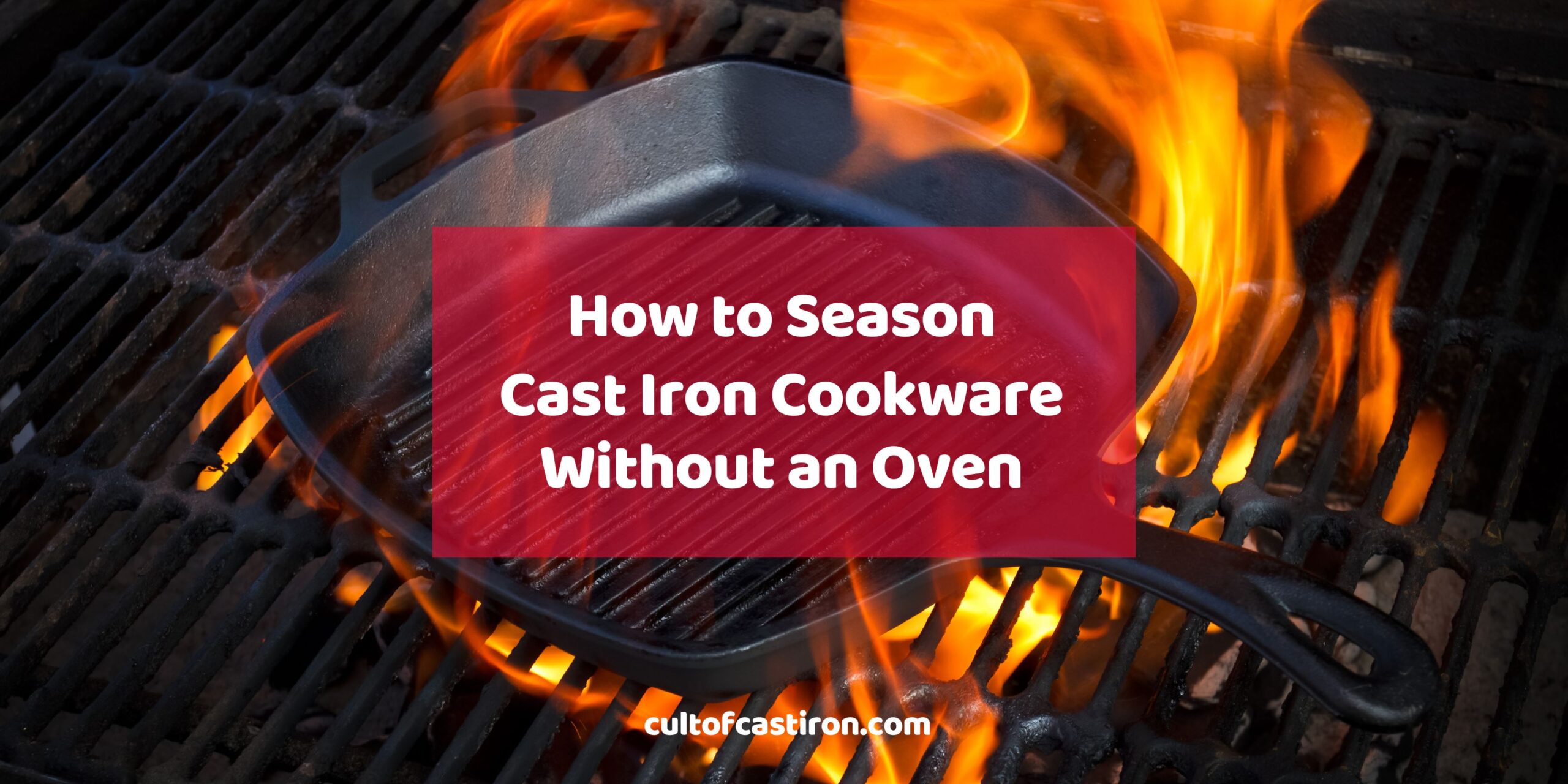In case you need some sort of reminder, cast iron pans are amazing! They can cook anything from steaks to pancakes, lasting for generations if you take good care of them. But caring for them means seasoning them properly to create a non-stick and rust-resistant surface on the metal.
If you’ve ever searched for ways to season a cast iron pan, you might have noticed that most guides tell you to use an oven. And while that’s certainly the easiest and most foolproof way to do it, it’s not the only way. You can also season cast iron without an oven using other heat sources you might already have at home.
In this article, we’ll show you how to season your cast iron pan on a stove, on a grill, or even over an open fire. Read on, as we’ll also give you tips and tricks on how to do it right and avoid common pitfalls.
What are you waiting for? Grab your cast iron pans now, and let’s get started!
The Four Basic Steps to Cast Iron Seasoning
Seasoning your cast iron pan is not as hard as it sounds. It’s simply a way of applying a thin layer of oil to the metal and heating it until it forms a protective coating that prevents rust and sticking. When done right, it can improve the performance and durability of your cast iron pan.
But before we dive into the different seasoning methods, let’s review the four basic steps to cast iron seasoning.
- Rub the cooking oil of choice on the pan. You can use any oil with a high smoke point, such as vegetable, canola, or grapeseed oil.
- Remove as much oil as you can with a paper towel. You want a very thin layer of oil that coats the entire surface of the pan, inside and out.
- Heat the pan until it reaches the smoke point of the oil. This is when the oil polymerizes and forms a protective layer on the metal.
- Repeat the process until you achieve a smooth and shiny surface. Depending on the condition of your pan, you might need to do this several times.
For the purpose of this article, we will only focus on step #3. Check out our comprehensive blog here for a more detailed guide on cast iron seasoning.
One important thing to note is that the following methods don’t offer the same accurate temperature control as an oven. As such, we recommend investing in an infrared thermometer, which can measure the surface temperature of your pan without touching it. This will help you avoid overheating or underheating your pan, which can affect the quality of the seasoning.
How to Season Cast Iron Without an Oven
In case you don’t have an oven or you just want to try something different, you can season cast iron without an oven using other heat sources! Each method has its own advantages and disadvantages, so choose the one that suits your needs and preferences best.
How to Season Cast Iron on a Stove
Seasoning on a stove is probably the most convenient method if you can’t access an oven. All you need is your stove, cast iron pan, and oil.
This method is fast and easy, but it requires some attention and care to avoid uneven or burnt seasoning.
- Place your pan on the stove and turn on the heat. The heat setting will depend on the cooking oil of choice, but medium-high to high will be fine. You can fine-tune the temperature as you go.
- Rotate the pan every five minutes to ensure even heat distribution. Since stove flames typically have a small coverage area, rotating the pan will prevent hot and cold spots.
- Wipe off the surface once in a while with paper towels and tongs. In an oven, you usually place the pan upside down to let excess oil drip away from the pan. This may not be an option on the stovetop because of its small size. Wiping off the pan’s surface will prevent oil from pooling, especially if the pan is particularly uneven. This prevents your seasoning from flaking later on.
- Wait for the pan to turn matte black. This is an indication that the polymerization of the oil is complete.
How to Season Cast Iron on a Grill
This method is great if you have a large grill that can accommodate your cast iron pan. Plus, you can enjoy the outdoors while seasoning your pan!
- Wait for the charcoal to become embers before placing your pan on the grill. Open flames from coals tend to burn too hot, which could burn off the seasoning and make it flaky. Make sure to spread the charcoal evenly to cover the whole shape of the pan.
- Place your pan face down over the coals. This will prevent oil from pooling on the surface of the pan.
- Put the lid on and monitor the temperature. Putting the lid on will help distribute heat evenly, even on the part that is not directly sitting under the coals. Also, most grills have a built-in thermometer on their lids, which will come in handy when it comes to monitoring the temperature.
- Wait for the pan to turn matte black. This is an indication that the polymerization of the oil is complete.
How to Season Cast Iron over an Open Fire
This is probably the hardest method due to the unpredictability and intensity of open fires. Doing it wrong can cause the seasoning to burn and flake off later on.
However, if you’re feeling adventurous and want to try it out, this method can give your pan a rustic and authentic look and feel.
- Place some grates over the fire. You want to use sturdy and stable grates that can hold the weight of your pan. Remember, avoid placing your pan directly on the flames, as this can damage the seasoning and the metal.
- Heat your pan on one side until it smokes. This is when the oil starts to polymerize and form a protective layer on the metal. Be careful not to overheat your pan, though.
- Remove from flame, then repeat on the other side. You want to ensure that both sides of your pan are seasoned properly, so flip your pan over and repeat the process on the other side.
- Wipe off the surface once in a while with paper towels and tongs. Wiping off the pan’s surface will prevent oil from pooling and distribute the excess to the drier parts of the pan.
- Wait for the pan to turn matte black. This is an indication that the polymerization of the oil is complete.
Seasoning Your Cast Iron: No Oven? No Problem!
There are several ways to season your cast iron pan without an oven. All you need are some alternative heat sources, some cooking oil, and some patience.
You can use your stove, grill, or even an open fire to create a smooth and shiny surface on your metal. This will protect your pan from rust and sticking and make it cook better and last longer. It might take some trial and error, but once you master the art of seasoning without an oven, you’ll enjoy the benefits of cast iron cooking for a lifetime!
If you want to learn more about how to care for and use your cast iron pan, check out more of our blogs at Cult of Cast Iron, where we share our passion for all things cast iron!

Miguel is a cast iron enthusiast from Cavite, Philippines. He works in the digital marketing field as a content marketing strategist. On the side, he manages a small online bookstore and tends to his plants.

